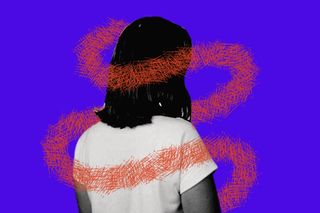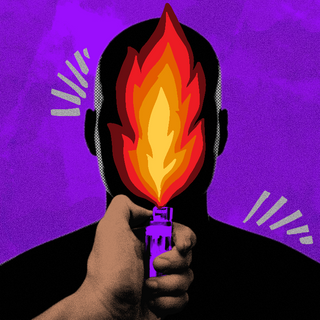
The Difference Between a Panic Attack and an Anxiety Attack, Explained
Experts believe that, objectively, the immediate symptoms of panic attacks are more intense than those of anxiety attacks.

“Anxiety attacks” and “panic attacks” are terms that are often used interchangeably — and sometimes, even treated as synonyms for experiencing an absolutely normal amount of anxiety about, say, an upcoming exam. But although they overlap, they describe different experiences.
Both anxiety attacks and panic attacks can be distressing. But with stories of mental health misdiagnoses being a dime a dozen, awareness of the difference between the seemingly indistinguishable conditions can make it easier for one to advocate for themselves. Especially given how easy it appears to confuse the two — especially for an external observer — being cognizant of one’s experience can be key to getting the right kind of help, sooner than later.
According to Namita Ruparel, an assistant professor at the Jindal Institute of Behavioral Sciences, a panic attack can occur without warning at the mere prospect of a perceived threat. “Panic attacks are sudden while anxiety attacks are gradually built over thoughts [and] is generally rooted in [one’s] present circumstances,” she told The Indian Express. “A chain of unpleasant thoughts accompanied by worry, tension, nervousness, and intrusive thoughts about the future, and the expectation that something unpleasant may occur is termed as anxiety… [It can impact] heart rate, blood pressure, insulin levels, to name a few.”
Regular panic attacks for seemingly no reason have a separate diagnosis: panic disorder. They’re typically associated with bereavement, a close relative with the disorder, or neurochemical imbalance, through the exact causes remain unclear. Some people can get panic attacks without a prior history of anxiety or an anxiety disorder diagnosis.
Related on The Swaddle:
Workplace ‘Rust Out’ Is As Bad For Our Mental Health As Burnout. What Does It Look Like?
Unlike anxiety attacks, which are often dubbed “flare-ups of a generalized anxiety disorder,” panic attacks are clinically recognized by the Diagnostic and Statistical Manual. The fifth edition of the same — or the DSM-5, as we know it — suggests that encountering more than four of the following symptoms can categorize an experience as a panic attack:
- a pounding heart;
- pain, or any other form of discomfort, in the chest;
- shortness of breath;
- sweating;
- trembling;
- a choking sensation;
- nausea, if not any other gastric symptoms;
- dizziness;
- chills and hot flashes;
- numbness — or, on occasion, tingling sensations — in parts of one’s body;
- a sense of dissociation from one’s immediate environment, the reality, or even, one’s own body;
- a pervasive sense of doom; and
- a rapidly setting fear of losing control.
The fact that anxiety attacks aren’t recognized by the DSM-5 doesn’t, however, make it any less legitimate than a panic attack. According to Healthline, “The lack of diagnostic recognition of anxiety attacks means that the signs and symptoms are open to interpretation… That is, a person may describe having an ‘anxiety attack’ and have symptoms that another person has never experienced despite indicating that they, too, have had an ‘anxiety attack.'”
However, experts do believe that, objectively, the immediate symptoms of panic attacks are “more intense.” Anxiety attacks, on the other hand, can feel akin to a wave of anxiety washing over a person. They’re also often in response to a perceived threat or a fear building over time — unlike panic attacks, which can occur unprompted, and for seemingly no reason.
Related on The Swaddle:
The Difference Between Binge‑Drinking and Alcoholism, Explained
There’s also a difference in the duration of an anxiety attack and a panic attack. The latter is believed to be shorter — typically lasting only a few minutes, although it can occasionally, be longer or shorter. The duration of an anxiety attack, however, can be up to 30 minutes. Having said that, though, going through either can make it seem as though the experience lasted a lifetime.
Thankfully, there are a number of ways to treat both — ranging from breathing exercises and grounding techniques that can be used to calm oneself down in the moment to long-term recourses in the form of therapy and medication.
But as Dr. Ramnarine Boodoo, a psychiatrist, advises, it’s important to never tell a person in the middle of a panic attack: “Don’t worry.” He says, “They’re going to worry. It’s that intense… You can actually add to the angst of the moment by suggesting they stop doing the very thing they’re unable to in the moment.”
As we get more aware of our emotions using incorrect terminology helps no one — least of all ourselves. Not only can it interfere with one’s diagnosis and treatment, it can also make people prone to the perception that they’re simply exaggerating their symptoms. In a world where many still tend to take mental health lightly, the latter can be painful to deal with.
Devrupa Rakshit is an Associate Editor at The Swaddle. She is a lawyer by education, a poet by accident, a painter by shaukh, and autistic by birth. You can find her on Instagram @devruparakshit.
Related


Is Solo Polyamory a Sexuality or Just a Lifestyle Choice?
